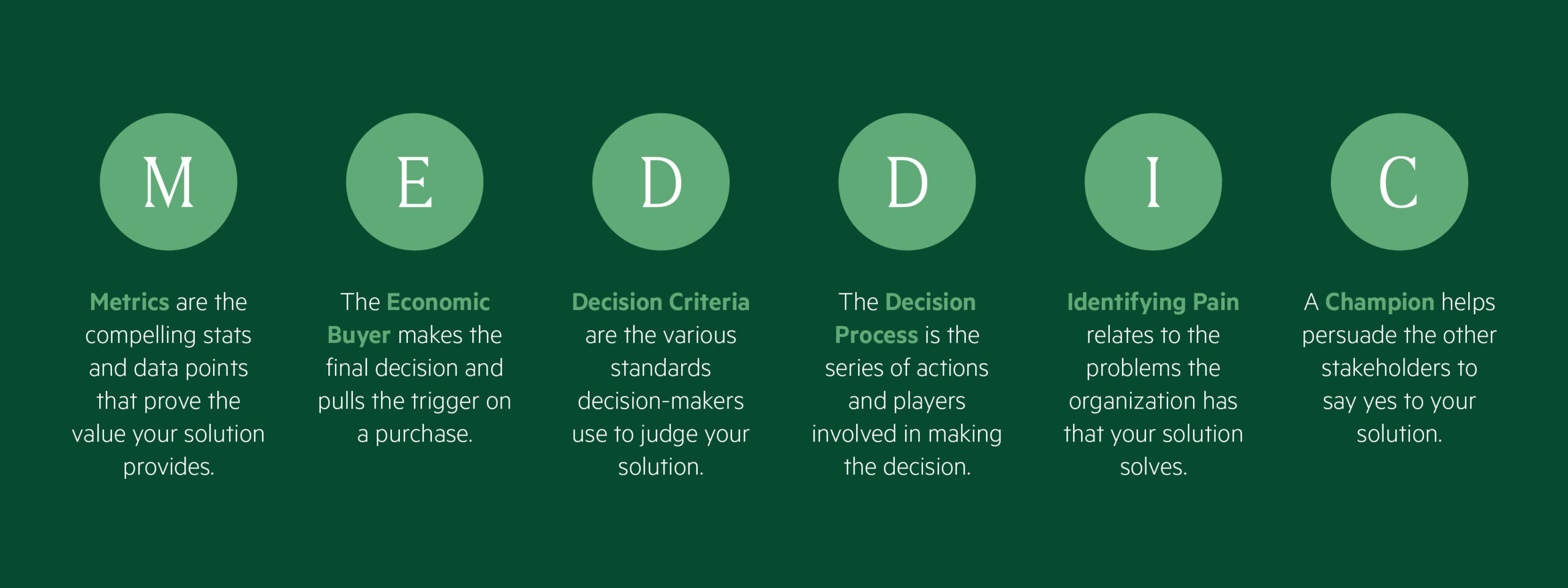B2B sellers have one major challenge in common: navigating the complex B2B buying process to get more wins. We all know enterprise sales are complex, which is probably why so many sales methodologies have cropped up over the years – SPIN selling, GAP selling, challenger selling – the list goes on.
However, MEDDIC is one sales methodology that has stood the test of time. MEDDIC helps sellers accurately gauge deal strength so they can stop wasting time chasing the wrong opportunities. MEDDIC allows reps to focus on people and activities that move deals forward.
Andy Whyte, the author of MEDDICC the book, experienced firsthand how this methodology improved his results as a sales rep and leader. Andy has worked for leading sales organizations, including Oracle and Sprinklr, and has sold to some of the world’s largest enterprises.
To help revenue teams harness the power of MEDDIC, we’re sharing his top tactics for attracting customers, holding effective sales meetings, and beating your competitors.
What Is MEDDIC?
MEDDIC is a tool that helps B2B sellers evaluate opportunities and stop wasting time on dead-end deals and decision makers. It helps reps work smarter – not harder, which is critical in complex enterprise sales.
MEDDIC stands for Metrics, Economic buyer, Decision criteria, Decision process, Identify pain, and Champion. It helps reps determine whether or not they should pursue a different decision maker or focus their attention on a more promising deal.

1. Use Metrics To Cut Through the Noise
One of the biggest challenges for B2B sellers is competing in oversaturated markets. Consistent multi-channel communication is only as good as the message you are sending. Your message must embody the following qualities to cut through the distractions:
- Concise
- Relevant
- Credible
What specific benefits does your solution provide to customers? Make sure that anytime you mention “value” you can support it with quantifiable and measurable metrics. The two most compelling metrics to include in sales messaging:
RESULTS FROM YOUR EXISTING CUSTOMER BASE
Your customer stories and case studies come in handy here. For example, we pulled this compelling stat from a business case we created working with our client FedEx:
“3M’s implementation of Salesloft in the US and Canada occurred during the pandemic with the inside sales team working remotely. The first Salesloft Cadence reached a whopping 1,000 customers in a week.”
STATS THAT ILLUMINATE THE PROSPECT’S PAIN POINTS
Use metrics to highlight the consequences of not taking action. Spell out the implications of leaving their problem unsolved to create urgency in your prospect. Below are stats Salesloft uses to demonstrate the value of digitally empowering their sellers.
“Sellers are struggling to succeed. Even the best sales organizations plan for only 60% of their sellers to hit quota – and this number has been declining for the last decade.”
“That’s the biggest difference I see between elite salespeople and average salespeople – the amount of urgency they drive to help the customer.” – Andy Whyte, the author of MEDDICC the book
2. Do Your Research To Use Customer Pain Points Strategically
We’ve all heard the saying “the customer is always right” and other catch-alls about keeping customers happy. But the reality is, getting results in sales meetings requires reps to evoke customer pain, challenge them, and even make them feel uncomfortable at times.
Instead of keeping emotions high throughout the entire conversation, you should strategically touch on pain points that drive urgency and motivate prospects to take action. To make a lasting impact during your meeting, you must trigger a mixture of emotions, or else you risk losing their interest.
To make that lasting impact, get your prospects and customers excited by painting the picture of what their life could be like once they’ve solved their problem using your solution. Then, draw them back by reminding them of the issues they’re experiencing right now.
Here are the top 3 ways you can effectively evoke emotions in your sales meetings:
TALK ABOUT TOPICS THE CUSTOMER CARES ABOUT – HINT: IT’S NOT YOU
Many salespeople excitedly tell the story of their founders because, let’s face it: we’re interested in our own stories. However, it’s a mistake to think that the customer cares about what we’re interested in.
Before adding anything to your slide deck or talking points, ask yourself, why would my prospect care about this? Focus your talking points on what appeals to them – not you.
DO YOUR RESEARCH BEFORE THE MEETING
One of the easiest (and most powerful) ways to quickly build rapport with prospects is to show them you’ve done your research. We tend to appreciate or feel flattered by those who take a special, personalized interest in us.
EMPATHIZE AND RELATE
Sellers can fall into the trap of peppering their prospects with intrusive questions during discovery calls. After all, how can we confidently present our solution without first asking thoughtful questions? The problem is, many prospects feel that these questions highlight their shortcomings, causing them to become defensive or guarded.
Luckily, you can make your prospect feel more at ease by sharing your own company’s struggles or issues. To better relate with your prospect and put them at ease, think about the ways your company has struggled. What were some business challenges you’ve overcome or are actively working on?
Showing vulnerability can help buyers feel like you’ve experienced the same challenges and can help them overcome theirs. Using empathy humanizes your organization – transforming you from vendor to trusted partner.
3. Understand the Decision-Making Process to Beat Competition
It’s a pain to lose enterprise deals, since investing in them requires a lot of work. One of the biggest deal blockers is trying to sell according to your company’s process versus how the customer prefers to buy.
Fortunately, the MEDDIC methodology helps you stand out from your competitors because it helps you understand major buying criteria so you can tailor your approach.
Buying criteria tend to fall into three main categories:
TECHNICAL CRITERIA
- Does your product have the technical capability to meet the needs of the customer?
- What’s the buyer’s process for introducing and implementing your product? Is it going to be more of a hassle than they anticipated?
- Does your solution meet their infrastructure and security qualifications?
ECONOMIC CRITERIA
- Will your solution deliver evidence of return on investment (ROI)? If so, how will it be measured?
- How much time, money, and resources will the rollout of your product cost the customer?
- Is there an opportunity cost associated with your solution?
RELATIONSHIP CRITERIA
- Does the customer want to work with you? Has their experience within the sales process been enjoyable for them?
- Have you listened to the stakeholders’ individual needs and gained their trust in your solution?
- Does your roadmap align with their goals?
4. Increase sales velocity with the flywheel effect
While many companies use the term “funnel” to describe their marketing and sales process, “flywheel” has become the newest buzzword. This framework better aligns with the nonlinear way customers buy and interact with brands today. It puts customers (and their desires) at the center of your business rather than at the bottom of a funnel.

Companies like Amazon have redefined consumer expectations. In general, we’ve come to expect convenient, frictionless buying experiences. Using MEDDIC in your sales process can help you provide the highly personalized experience that B2B buyers have come to expect.
To create a flywheel effect, companies must view the customers themselves as the main drivers of the business. Amazon is a prime example of a company that aligned its entire organization around remarkable customer experience. To produce a flywheel effect, companies must embrace putting the customer experience first as a strategy to accelerate revenue and growth and continue to capitalize on that momentum.
The Bottom Line on how MEDDIC Can Transform Your Sales Process
Sellers use MEDDIC to qualify opportunities and gauge the influence of decision-makers and overall deal strength. When reps use MEDDIC to diagnose opportunities, they can work deals more strategically and avoid wasting time with the wrong people and activities.
Following the MEDDIC framework, sellers can learn to use compelling metrics in their sales messaging, conduct research that reveals customer pain points, and deeply understand the buying process to protect deals. This results in a “flywheel effect” where extraordinary customer experiences increase sales velocity and revenue growth.
Learn how MEDDIC can boost your sales results by watching the full webinar.


